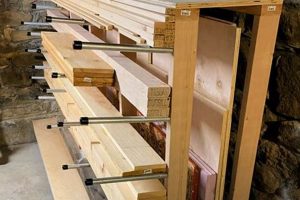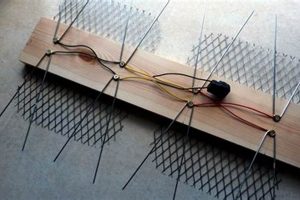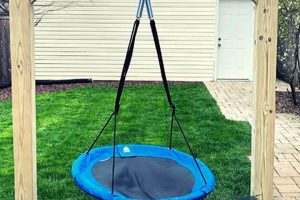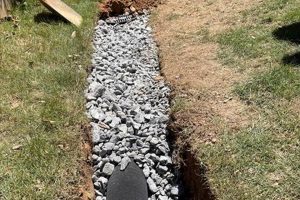A method for improving soil health and promoting vigorous turf growth involves creating perforations in the ground. This process facilitates air, water, and nutrient penetration to the root zone, which is often compacted in residential landscapes. These projects typically involve modifying existing tools or constructing new devices to puncture or remove small plugs of soil.
The practice of aerating residential grasses can address issues such as thatch buildup, soil compaction from foot traffic or machinery, and poor drainage. It contributes to a healthier, more resilient lawn, improving its appearance and resistance to disease. Historically, aeration was primarily performed by professional landscaping services, but resourcefulness and cost considerations have led to increased homeowner involvement in the development and employment of alternative approaches.
The following sections will explore various techniques, tool modifications, and design considerations relevant to performing this essential task independently, along with factors affecting effectiveness and long-term lawn health.
Effective Lawn Aeration Techniques
Achieving successful lawn aeration requires careful planning and execution. The following recommendations can optimize the process and promote long-term turf health.
Tip 1: Assess Soil Compaction. Prior to initiating any aeration, determine the degree of soil compaction. A simple test involves attempting to push a screwdriver into the ground. Significant resistance indicates a need for aeration.
Tip 2: Select the Appropriate Method. Options range from spike aerators to core aerators. Spike aeration is suitable for minor compaction, while core aeration, which removes plugs of soil, is preferable for more severe cases.
Tip 3: Time Aeration Strategically. The optimal time for aeration is during the grass’s active growing season. For cool-season grasses, this is typically in the fall or early spring. Warm-season grasses benefit most from aeration in late spring or early summer.
Tip 4: Ensure Adequate Soil Moisture. Aeration is most effective when the soil is moist but not saturated. Water the lawn a day or two before aerating if necessary.
Tip 5: Control the Aeration Depth and Spacing. Aim for a depth of at least two to three inches. Space the holes or plugs two to four inches apart for optimal results.
Tip 6: Consider Multiple Passes. For severely compacted soil, making multiple passes with the aeration tool, overlapping slightly, can improve soil structure.
Tip 7: Fertilize and Overseed After Aeration. Following aeration, apply fertilizer and overseed, if necessary, to take advantage of the improved soil conditions. This promotes quicker recovery and denser turf growth.
Tip 8: Clean and Maintain Tools. Properly clean and maintain aeration tools to ensure their longevity and continued effectiveness.
By implementing these strategies, aeration can effectively alleviate soil compaction, improving nutrient uptake, water infiltration, and overall lawn health.
The subsequent discussion will address the selection of aeration tools and potential modifications for enhanced performance.
1. Tool Selection
The selection of appropriate tools is a foundational element in any aeration project. The efficacy of the process is directly linked to the chosen implements and their ability to effectively perforate or extract soil. For instance, a homeowner addressing minor compaction in sandy soil might opt for a rolling spike aerator, which creates small channels for air and water penetration. Conversely, dense clay soils require a more robust solution, such as a drum-type core aerator. Improper tool selection will necessitate either unnecessary effort or prove entirely ineffectual, leading to minimal improvements in soil structure and root development.
Modifying existing gardening tools to serve as a custom aeration device involves careful consideration of the implement’s existing functionality and the required alterations for effective aeration. An example of this would be adapting a garden fork by reinforcing the tines and adding a foot platform to increase force during soil penetration. The inherent limitations of the base tool impact the range of modifications possible and the potential performance of the resulting device. Furthermore, the durability of the modified tool must be assessed; a structurally weak modification could lead to premature failure, rendering the entire endeavor futile.
Ultimately, the tool selection phase of lawn aeration dictates the practical limitations and potential successes of the project. Thorough consideration of soil type, compaction level, and the inherent capabilities of available tools is critical for achieving meaningful improvements in turf health. Ignoring these factors risks wasted time, effort, and resources, underscoring the importance of informed decision-making at the outset of any aeration endeavor.
2. Design Modification
The functionality and effectiveness of a “diy lawn aerator” are intrinsically linked to design modification. The base components or existing tools that form the foundation of such a project often necessitate alterations to adequately perform the function of soil aeration. These modifications directly influence the depth of penetration, the type of aeration achieved (spiking versus core removal), and the overall durability and usability of the tool. Without carefully considered design changes, a homemade aeration device may prove inadequate, leading to minimal improvements in soil conditions and wasted effort. For instance, a simple roller might be enhanced by welding spikes to its surface, transforming it into a basic spike aerator. The design of these spikes their length, thickness, and spacing fundamentally dictates the tool’s aeration capacity.
Design modification extends beyond simply adding components; it encompasses adapting ergonomics and functionality for ease of use and efficiency. Examples include adding weight to a spike aerator to increase soil penetration force or adjusting the handle length and angle to reduce user fatigue. Core aerators often require more complex modifications, involving mechanisms for ejecting soil plugs and ensuring consistent plug depth. Moreover, safety features must be integrated into the design to prevent injury during operation. Therefore, design modification represents a critical stage in the development of a useful aeration tool, dictating its practicality and effectiveness in improving lawn health.
In conclusion, design modification stands as an indispensable element in the successful construction of a homemade lawn aerator. Thoughtful alterations to existing tools or components directly impact the tool’s ability to aerate effectively, its ease of use, and its long-term durability. An understanding of design principles, combined with practical considerations for soil type and lawn
conditions, is essential to achieving the desired outcome: a healthier, more vibrant lawn.
3. Material Durability
Material durability is a primary determinant of the lifespan and effectiveness of any aeration device. The selection of robust materials is essential when undertaking such a project, as the tool will be subjected to repeated stress and abrasive conditions within the soil. Selecting components with inadequate strength or resistance to corrosion may lead to premature failure and necessitate frequent repairs or replacements, negating any initial cost savings.
- Tine Construction
The tines of a spike or core aerator are the primary points of contact with the soil, bearing the brunt of the force during operation. Mild steel tines are susceptible to bending and breakage, particularly in compacted soils. Hardened steel or alloy alternatives provide significantly greater resistance to deformation and wear, extending the operational life of the tool and maintaining consistent aeration depth.
- Frame Integrity
The structural frame supports the tines and distributes the user’s force across the aeration surface. Welded joints and frame members must be capable of withstanding repeated stress without cracking or bending. Square or rectangular steel tubing offers improved strength compared to round tubing, minimizing the risk of structural failure under load.
- Corrosion Resistance
Exposure to soil moisture and organic matter can accelerate corrosion, weakening metal components over time. Applying a protective coating, such as powder coating or galvanization, can significantly inhibit rust formation and extend the lifespan of the aerator. Stainless steel components offer inherent corrosion resistance but are typically more expensive.
- Fastener Selection
Bolts, nuts, and other fasteners are critical for maintaining the integrity of the aerator assembly. Low-grade fasteners can shear or loosen under stress, compromising the stability of the tool. High-strength fasteners, coupled with locking mechanisms such as nylon insert locknuts, provide a more secure and reliable connection, minimizing the need for frequent retightening and preventing catastrophic failure.
In conclusion, the selection of durable materials is a non-negotiable aspect of creating a long-lasting and effective lawn aerator. While cost may be a factor, prioritizing quality components will ultimately prove more economical by reducing maintenance requirements and extending the usable life of the tool. A well-constructed aerator, fabricated from robust materials, represents a worthwhile investment in long-term lawn health and requires minimal expenditure for upkeep.
4. Aeration Depth
Aeration depth, referring to the extent to which a lawn aeration tool penetrates the soil, is a critical factor influencing the effectiveness of the process. The selection of an appropriate penetration depth is directly relevant to the design and implementation of lawn aeration tools.
- Root Zone Access
The primary purpose of lawn aeration is to alleviate soil compaction and facilitate the movement of air, water, and nutrients to the root zone. Inadequate penetration depth limits the effectiveness of aeration, as the benefits remain confined to the upper layers of the soil, failing to reach the deeper root systems. For example, if the root zone extends to six inches, an aeration depth of only one inch will provide minimal benefit. The selection of proper depth therefore directly impacts root health and subsequent turf vigor.
- Soil Type Considerations
Varying soil compositions necessitate adjustments in aeration depth to optimize results. Clay soils, characterized by their dense structure and high compaction potential, generally require deeper penetration to effectively fracture the soil profile and improve drainage. Sandy soils, with their inherent porosity, may benefit from shallower aeration to enhance nutrient retention. The tools capacity to adjust for different soil types is thus a significant design consideration.
- Tool Design and Modification
The design of an aeration tool dictates the achievable penetration depth. Spike aerators, with their solid tines, typically offer limited depth compared to core aerators, which remove plugs of soil. Modification of existing tools often involves altering the length or configuration of the tines to achieve the desired penetration. However, it is crucial to ensure that such modifications do not compromise the structural integrity of the tool.
- Energy Expenditure and Usability
The force required to achieve a specific aeration depth directly affects the usability of the tool. Deeper penetration often necessitates greater force, potentially leading to user fatigue and reduced efficiency. Design considerations should aim to balance the benefits of deeper aeration with the ergonomic factors affecting the user’s ability to operate the tool effectively. The inclusion of features such as weighted rollers or leverage-enhancing handles may mitigate the effort required.
Therefore, the determination of optimal aeration depth is a multifaceted consideration intertwined with soil type, tool design, and user effort. A thorough understanding of these relationships is paramount to ensure that lawn aeration efforts yield tangible improvements in soil health and turf quality. The development of DIY aeration tools necessitates the consideration of design factors affecting maximum achievable aeration depth.
5. Puncture Spacing
Puncture spacing, defined as the distance between individual holes created during aeration, fundamentally influences the effectiveness of any lawn aeration methodology, particularly in the context of DIY lawn aerator construction and utilization. Inadequate puncture spacing, characterized by overly sparse hole distribution, results in localized soil decompaction, failing to provide sufficient pathways for air, water, and nutrient infiltration throughout the root zone. Conversely, excessively dense puncture spacing can weaken the soil structure, potentially leading to surface instability and increased susceptibility to drought stress. The selection of appropriate puncture spacing, therefore, becomes a critical design parameter in ensuring optimal aeration outcomes.
The practical implications of puncture spacing manifest in observable differences in turf health. For instance, if a drum-type core aerator, constructed independently, features tines spaced six inches apart, the resulting aeration pattern might prove insufficient for addressing widespread soil compaction. Visible improvements in turf density and color may be localized to areas immediately surrounding the aeration holes, while intervening regions remain unaffected. Conversely, an attempt to maximize aeration by spacing punctures too closely together, for example, at one-inch intervals, can create a destabilized soil surface, increasing the risk of soil erosion and root damage, particularly on sloped terrains. Thus, the construction of a lawn aerator must take proper puncture spacing i
nto account.
In summary, puncture spacing plays a pivotal role in determining the overall effectiveness of lawn aeration. Balancing adequate soil decompaction with maintaining structural integrity requires careful consideration of soil type, compaction level, and the specific design of the DIY aeration tool. By adhering to established guidelines for puncture spacing, individuals can maximize the benefits of aeration, promoting a healthier and more resilient lawn. Ignoring this critical parameter can lead to suboptimal results or even detrimental effects, highlighting the importance of informed decision-making in the construction and application of homemade aeration tools.
6. Cost Effectiveness
The primary motivation for undertaking a do-it-yourself lawn aeration project frequently stems from the pursuit of cost effectiveness. Commercial lawn aeration services represent a recurring expense, particularly for larger properties or in regions with heavy clay soils prone to compaction. Constructing a homemade aeration device, while demanding initial effort and investment, can mitigate these ongoing costs. The economic viability of this approach, however, hinges on several factors, including the cost of materials, the labor involved, and the longevity of the resulting tool.
The equation of cost effectiveness extends beyond the simple comparison of initial outlay versus professional service fees. It involves an assessment of the tool’s performance over time. A poorly constructed device requiring frequent repairs or exhibiting limited effectiveness in addressing soil compaction may ultimately prove more expensive than contracting with a professional service. Therefore, judicious selection of durable materials, careful adherence to sound design principles, and a realistic appraisal of one’s own capabilities are paramount to achieving genuine cost savings. For instance, repurposing salvaged materials can reduce the financial burden, but it should not compromise the structural integrity or functional performance of the aerator. An example is using an old garden roller and welding spikes to it, if the roller is available already.
Ultimately, the cost effectiveness of a DIY lawn aeration project rests on a holistic evaluation encompassing material costs, labor input, tool longevity, and aeration efficacy. While the potential for significant savings exists, realizing these savings necessitates a commitment to quality construction, informed design choices, and a realistic assessment of the challenges involved. A well-executed DIY lawn aerator project can represent a sound investment in long-term lawn health, delivering both economic benefits and the satisfaction of self-sufficiency.
7. Maintenance
The longevity and effectiveness of a “diy lawn aerator” are inextricably linked to consistent and thorough maintenance. Neglecting this critical aspect can lead to premature degradation of the tool, diminished performance, and ultimately, negate the cost savings that motivated the project in the first instance. The causal relationship between maintenance practices and the lifespan of the device is direct: diligent care extends operational life, while neglect accelerates deterioration. The importance of maintenance as a component of “diy lawn aerator” ownership cannot be overstated, as it ensures the tool remains functional and capable of performing its intended purpose: effectively aerating the lawn.
Practical applications of this understanding involve implementing a regular maintenance schedule. After each use, the aeration device should be thoroughly cleaned to remove soil, debris, and organic matter that can contribute to corrosion or impede moving parts. Tines should be inspected for damage, such as bending or breakage, and promptly repaired or replaced. Lubrication of moving parts, such as axles or rollers, reduces friction and wear, extending the tool’s operational life. Furthermore, proper storage in a dry environment minimizes the risk of rust and degradation. For instance, a drum aerator stored outdoors without protection will experience accelerated corrosion compared to one stored in a shed.
In conclusion, the correlation between maintenance and the sustained performance of a “diy lawn aerator” is undeniable. The challenges associated with DIY construction, such as potential material limitations or design compromises, underscore the need for heightened attention to upkeep. By prioritizing consistent cleaning, inspection, repair, and proper storage, owners can maximize the lifespan of their aeration device, ensuring its continued effectiveness in promoting lawn health and achieving the intended economic benefits.
Frequently Asked Questions
The following addresses common inquiries regarding the construction and utilization of independently-built lawn aeration devices.
Question 1: What is the optimal tine spacing for a homemade core aerator?
Tine spacing should ideally range between two and four inches. Closer spacing can destabilize the soil, while wider spacing may result in insufficient aeration.
Question 2: Is spike aeration an acceptable substitute for core aeration?
Spike aeration is suitable for minor soil compaction. Core aeration, which removes soil plugs, provides superior results for heavily compacted soils.
Question 3: What materials are best suited for constructing durable aerator tines?
Hardened steel or alloy alternatives offer superior resistance to bending and breakage compared to mild steel. Stainless steel provides exceptional corrosion resistance but is typically more expensive.
Question 4: How can penetration depth be maximized in compacted clay soils?
Adding weight to the aerator or employing a lever-assisted design can increase the force applied to the tines. Pre-wetting the soil can also facilitate penetration.
Question 5: When is the ideal time of year to aerate a lawn?
The optimal time for aeration is during the grass’s active growing season. Cool-season grasses benefit most from fall or early spring aeration, while warm-season grasses thrive with late spring or early summer aeration.
Question 6: What maintenance procedures are essential for prolonging the lifespan of an aeration device?
Regular cleaning to remove soil and debris, inspection and replacement of damaged tines, lubrication of moving parts, and proper storage in a dry environment are critical maintenance procedures.
Careful planning and construction is essential for achieving a reliable lawn aerator.
The next section provides detailed explanations on improving soil’s components.
DIY Lawn Aerator
The preceding discussion has explored various facets of the “diy lawn aerator,” from design considerations and material selection to maintenance protocols and cost-effectiveness. Emphasis has been placed on the importance of careful planning, informed decision-making, and diligent execution in achieving a functional and durable device capable of promoting long-term lawn health. The interplay between design choices, material properties, and user effort has been highlighted as critical to successful aeration outcomes.
While commercial lawn aeration services offer a convenient alternative, the construction and utilization of a “diy lawn aerator” presents a viable path towards greater self-sufficiency and potenti
al cost savings. It requires a commitment to understanding the underlying principles of soil science and tool mechanics. Through the knowledge and resources outlined, individuals can address soil compaction issues independently, fostering a healthier, more resilient lawn environment. The long-term benefits of this endeavor extend beyond mere aesthetics, encompassing improved water conservation, reduced fertilizer requirements, and enhanced ecosystem health.







